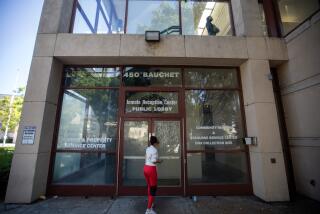Block Denies Cluster of Infection at Central Jail
- Share via
Sheriff Sherman Block Thursday denied reports from some county health department physicians that an apparent cluster of a deadly bacterial infection had been found at the Los Angeles Central Jail.
“A serious problem with infectious disease does not exist” at any of the county’s jails, Block said.
The sheriff acknowledged that 12 cases of meningococcal infections had been diagnosed among inmates in 1986 and that one inmate had died. He said three cases and no deaths had been reported so far this year. However, he dismissed as “misleading and erroneous” statements by two health department doctors that suggested that there was a health problem at the Central Jail.
“These cases were not limited to any specific (jail) facility,” the sheriff said in a prepared statement.
Health department doctors, however, said they made their statements because all of the infected inmates had passed through the Central Jail when first taken into custody.
Dr. John H. Clark Jr., the jail system’s chief physician, said in an interview that all new inmates are warned to avoid close contact because of an increase in meningitis, AIDS and hepatitis in the county jail system. But he said he does not believe that there is evidence to say there is a cluster.
He said six cases of the meningococcal infection, which causes spinal meningitis, occurred among inmates at the Peter J. Pitchess Honor Rancho (population 5,900) in Castaic, five at the Central Jail downtown (population 6,800) and one at Biscailuz Center in East Los Angeles (population 1,700). Another jail official said that the three cases reported this year involved inmates at each of the three facilities.
Clark acknowledged that all inmates are initially processed at the Central Jail before a decision is made to keep them there or send them to other jails. But Clark said he believes that it is “very unlikely” that all of the inmate cases came from exposure at the Central Jail.
He noted that the incubation period for the meningococcal infection is from two to 10 days but that inmates who fell ill had been in jail an average of 41 days. He said one inmate had been in jail only one day when he was diagnosed. He also noted that the cases were spread throughout the year.
But one of the health department doctors reiterated his belief that the Central Jail was the likely place where the infections were being transmitted.
“The rate of cases in the jail system is tenfold higher than in the general population,” said Dr. Steve Waterman, chief of acute communicable diseases for the county. “(The inmates) are not all in the Central Jail at the time they become ill. Everybody is booked through the Central Jail, and they stay for a couple of days before going somewhere else.”
Los Angeles County is experiencing a dramatic outbreak of the infection. Since December, county health officials have counted 120 cases countywide, including 26 deaths.
Dr. Peter Heseltine of County-USC Medical Center, who said Wednesday that about a dozen Central Jail inmates had been hospitalized for the infection, referred a reporter Thursday to health department spokeswoman Toby Staheli. She said that disagreement about whether there is a cluster of cases at the Central Jail may have been due to different methods of counting. In their count of 12 cases, hospital personnel included patients who had become ill at home soon after they were discharged from the Central Jail, Staheli said.
Meningococcal disease is spread through the air and by close contact and usually results in mild, cold-like symptoms. But the rare life-threatening form of the disease can cause a sudden characteristic rash, severe fever, headache and weakness.
More to Read
Sign up for Essential California
The most important California stories and recommendations in your inbox every morning.
You may occasionally receive promotional content from the Los Angeles Times.













